Identifying Weeds
- An Easy Guide to Some Common Ones
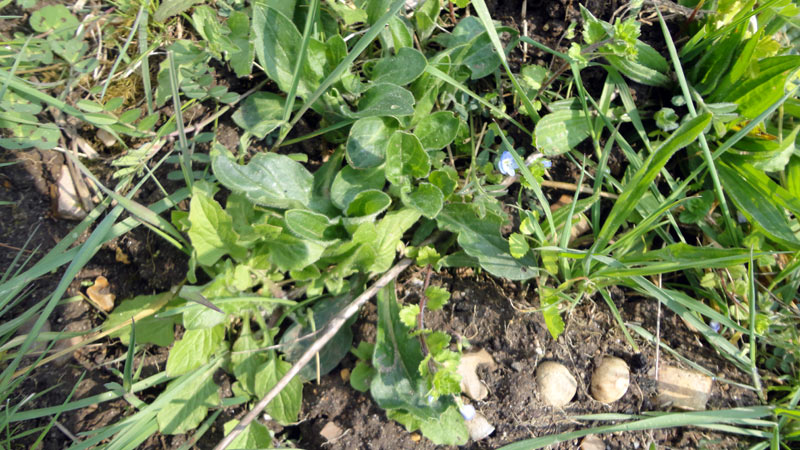
Identifying weeds: a useful skill for any gardener!
Weeding is one of those perennial tasks which does not go away - even if your garden is run according to the best management principles. Identifying weeds correctly is therefore a must. Some also happen to look a bit like common garden plants!
Picture: Mixed weeds in springtime. Identifying weeds when they are young can be difficult but is a valuable skill.
What's here?
On this page I will display pictures of some of the commonest monsters which afflict the home gardener in this corner of the world (the UK). Many of these are also found in other countries and climates. Some of our most intractable weeds now come from outside the UK and doubtless we have exported some too.
This brief guide to identifying weeds is mainly visual but I include some notes on how best to deal with them.
They are in alphabetical order.
First here are a few notes on how best to prevent and minimise weeds.
Reduce, recycle!
The best way to deal with weeds is not to have (m)any! Simple eh?
No, I'm not recommending you pave your garden, just mentioning some of the best ways of reducing your weeds by eco-friendly means. You are never going to reach the nirvana of a completely weed-free garden. But there are some ways you can cut down weeding time and effort without resorting to chemicals.
The main methods involve suppressing weeds by excluding light, and by building up fertlity in the soil which favours your chosen plants.
Once you have weeds more or less under control you can keep things in good order by frequent weed patrols. A small number of small weeds can be easy to eradicate by hoeing or hand weeding.
Identifying weeds:
Common weeds
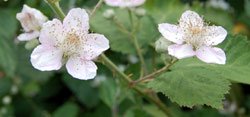
Bramble: the Devil's own weed! (But birds love it.) Very hard to pull up once it's past infancy. Grub it out with a mattock and be very vigilant for broken roots sprouting again. It also helps to smother it with heavy duty plastic or weed fabric. You can weaken the plant's structure by smothering it for some months before digging it out.
I'm sure no-one has any real difficulty in recognising brambles - the plant from which blackberries grow. In the spring I will photograph the seedling plant which can look quite innocent. Even, so they still have baby prickles as part of the young plant, so they can deliver an unpleasant scratch.
Bryony: an attractive but very poisonous climbing plant which grows exceptionally fast in spring. The flowers are a pale green with white petals. Notice the curly tendrils which cling onto other plants. This is one which is climbing a flowering redcurrant. The red berries belong to the bryony - not the redcurrant.
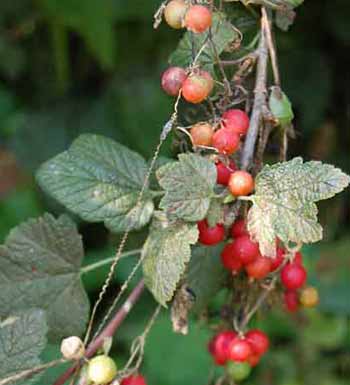
Bryony fruits entwined with a redcurrant plant
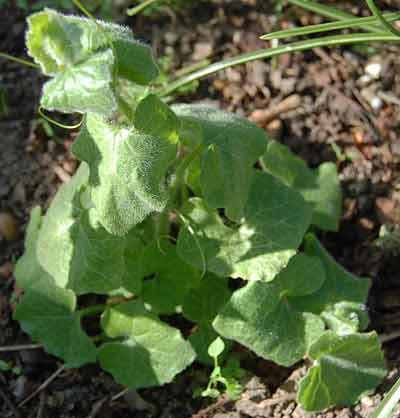
Picture above: A young white bryony growing quickly in spring
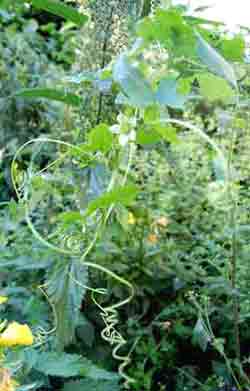
Picture above: Bryony will climb almost anything - including nettles
White bryony (Bryonia alba) is considered an invasive weed in the US. It certainly grows prolifically. Black bryony (Tamus communis) is prevalent in southern counties of England and is also poisonous. The leaves are more heart-shaped.
The fruits of white bryony go from pale green to bright red. They are very poisonous, so this is one to be fierce with if you have small children playing in the garden. It has beautiful curling tendrils like tightly coiled springs.
Identifying weeds such as bryony is easy once the plant is big and has berries. The young plant is also distinctive in the early spring as it grows so quickly.
Buttercup: sends runners out so it can be a persistent and rather choking threat top other plants. Dig it out carefully with a trowel, or hoe away in dry weather.
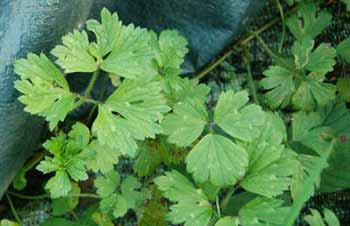
Buttercup leaves are quite distinctive. In this photo they should look about life-sized. I'm sure the pretty yellow flower needs no introduction! This creeping plant can be quite a difficult garden weed to eradicate as it spreads so easily. Uproot it with a trowel or fork and be sure to check for runners.
Campion - white (Silene latifolia)
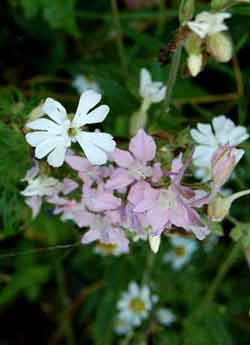
White campion may take up residence in country gardens. It's attractive but rather sprawling in habit. It likes open soils with a fair bit of sun.
It's fairly easy to check by pulling or hoeing, particularly if you take action early. Once the plant is large it can be difficult to pull by hand. Removing the tops can reduce the problem by preventing seeding. It is able to behave like a perennial if you do this. Naturally it is biennial or annual in habit i.e. each plant lives for one or two years only.
Red campion (Silene dioica) is more of a woodland edge and hedge species. It can tolerate full sun, especially at the northern edge of its range. If you live near woods you might find seedlings in your garden. I live right by some woodland but have not noticed it cropping up in my borders. It can hybridise with white campion to produce a lighter pink flower.
Identifying weeds - picture, right: white campion looks quite attractive in the flower bed but it has a sprawling habit which makes it less desirable. Here it is growing with pink larkspur.
Clovers
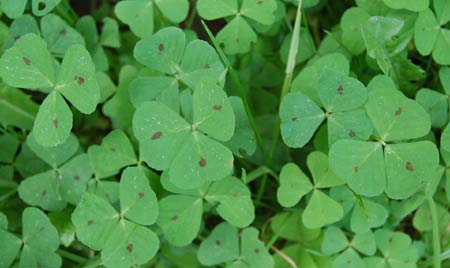
Clover: good green manure but can be a pest if unchecked. Hoe away in dry weather. There are several different common varieties but they all have the distinctive leaf shape. I love to keep such plants as clover in the lawn as they fix nitrogen and also look great.
Convolvulus:
This plant has deep and persistent roots. Double trench digging is supposed to be of some use but as the roots may stretch down metres into the soil, it is very difficult to completely eradicate it. Pull whenever you see it. If left unchecked it will climb up your plants and soon dominate them. Heavy mulches and weed mats are some help.
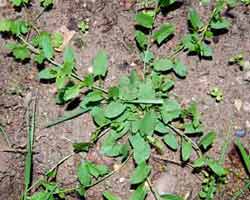
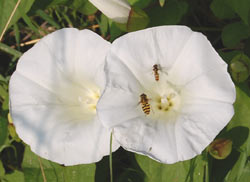
Picture, top: convolvulus starts as a low, creeping plant but it soon starts climbing up everything available.
Identifying weeds - picture, bottom: the larger species of convolvulus has large, showy white flowers. The small one usually seen in gardens is often pink or pink and white striped.
The flowers are attractive but this plant is a garden menace!
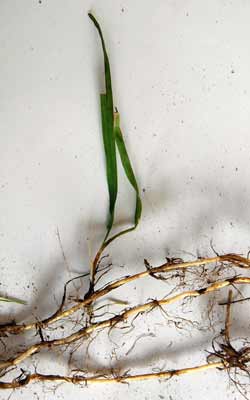
Couch grass:
A deep-rooted and difficult member of the grass family. Snapped off pieces of root easily sprout new plants. Careful working of the soil, digging each clump out with a fork and rake is probably the best strategy. Above ground, the grass looks much like any other. Below ground the stringy runners soon spread out and new plants appear from them. Identifying weeds that are this much trouble and so common is a must!
Dandelion
Great in salads but there is a limit to how much of it you want in your beds!
Use a special dandelion tool or a long narrow trowel to dig out the root. Snapped roots easily re-grow. I always leave dandelions in my lawn. They look great when in flower and the bees like them.
It's not so easy to grow enough for dandelion wine, which I made one year with moderate success. I found it a bit labour-intensive. Same goes for dandelion coffee but I guess it depends on where your priorities lie.
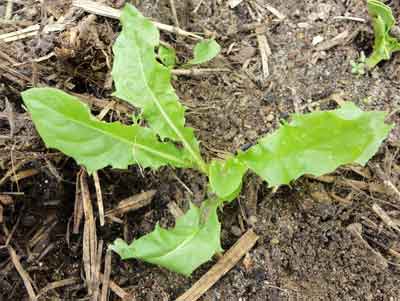
Identifying weeds - picture: Dandelion leaves have a characteristic serrated look which is hard to miss. Some of the very young leaves can be smooth.
Deadnettle (Lamium purpureum)
:
Red deadnettle is common in spring.
Deadnettle {red, purple or white) pulls fairly easily by hand. This is a good early food plant for bees and butterflies. It will thrive on uncut lawns in spring. It's a member of the mint family. It's not a nettle, of course and does not sting. The white version (Lamium album) is quite a common weed on cultivated soil and is also loved by bees.
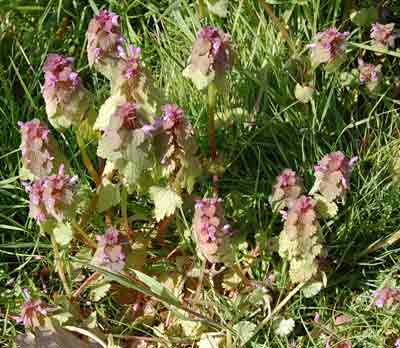
Dock: Deep roots make this a persistent and tricky weed to eradicate. Don't let it seed and use a trowel or spade to get the whole root if possible. Chop off any seeding tops early to prevent your garden being well seeded with this difficult weed.
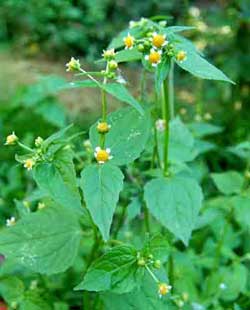
Gallant soldier (Galinsoga parviflora)
Picture: gallant soldier has small pretty white and yellow flowers
This American import can be pulled by hand, though parts often snap off. Easy to hoe. It can get to be quite large - over a foot tall.
The flowers are yellow-centred with small white petals.
It is reputed to be edible but I have not tried it as yet. Plants for a Future rate it as bland - and poisonous to goats.
Ground elder (Aegopodium podagraria)
Ground elder often swathes the ground beneath trees and shrubs. It is a member of the Umbelliferae - plants with flowers in umbels or large clusters. As such, it is similar to other species such as cow parsley. It is a perennial and spends most of the early part of the year as leafy ground cover. The white flowers emerge in late spring to summer, when it can easily get to two or more feet tall.
Ground elder is hopelessly pernicious. If you haven't got it anywhere in your garden inspect incoming plants carefully before you allow them in your soil! One of the hardest weeds to eradicate. Fortunately, you can eat it - but I haven't tried this yet.
Groundsel (Senecio vulgaris)
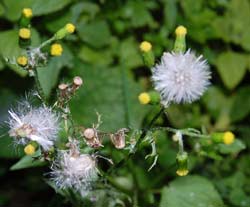
Groundsel is a plant that loves arable soil. It pulls easily by hand. Don't let it seed - the seeds blow about easily once ripe.
There are other types of Senecio which grow in a variety of habitats.
This plant is toxic but has a role in herbalism and homoeopathy.
Herb Robert
Herb Robert and other small geranium family weeds are easy to pull. Herb Robert can get quite big if left unchecked.
View more weeds here at Identifying Weeds - from K to Z
Sad to say, but most of the pictures for this page on identifying weeds were taken in my garden and allotment on one afternoon!
If you want to become adept at identifying weeds, a good guide with clear pictures is invaluable.
Identifying Weeds - An Easy Guide to Some Common Ones Copyright Greenfootsteps.com 2008
Please do not copy without permission. This site is protected by Copyscape
Green Garden - Organic Gardening
Greenfootsteps Home - for more easy green living ideas
| Tweet |

| Tweet |

On other pages
Identifying More Weeds: From K to Z
Controlling Weeds with Easy Organic Techniques
Choosing a Compost Barrel or Bin
Sponsored links
Footprints
- an occasional e-zine from Greenfootsteps
If you would like to receive the e-zine, please just sign up below.






New! Comments
Have your say about what you just read! Leave me a comment in the box below.